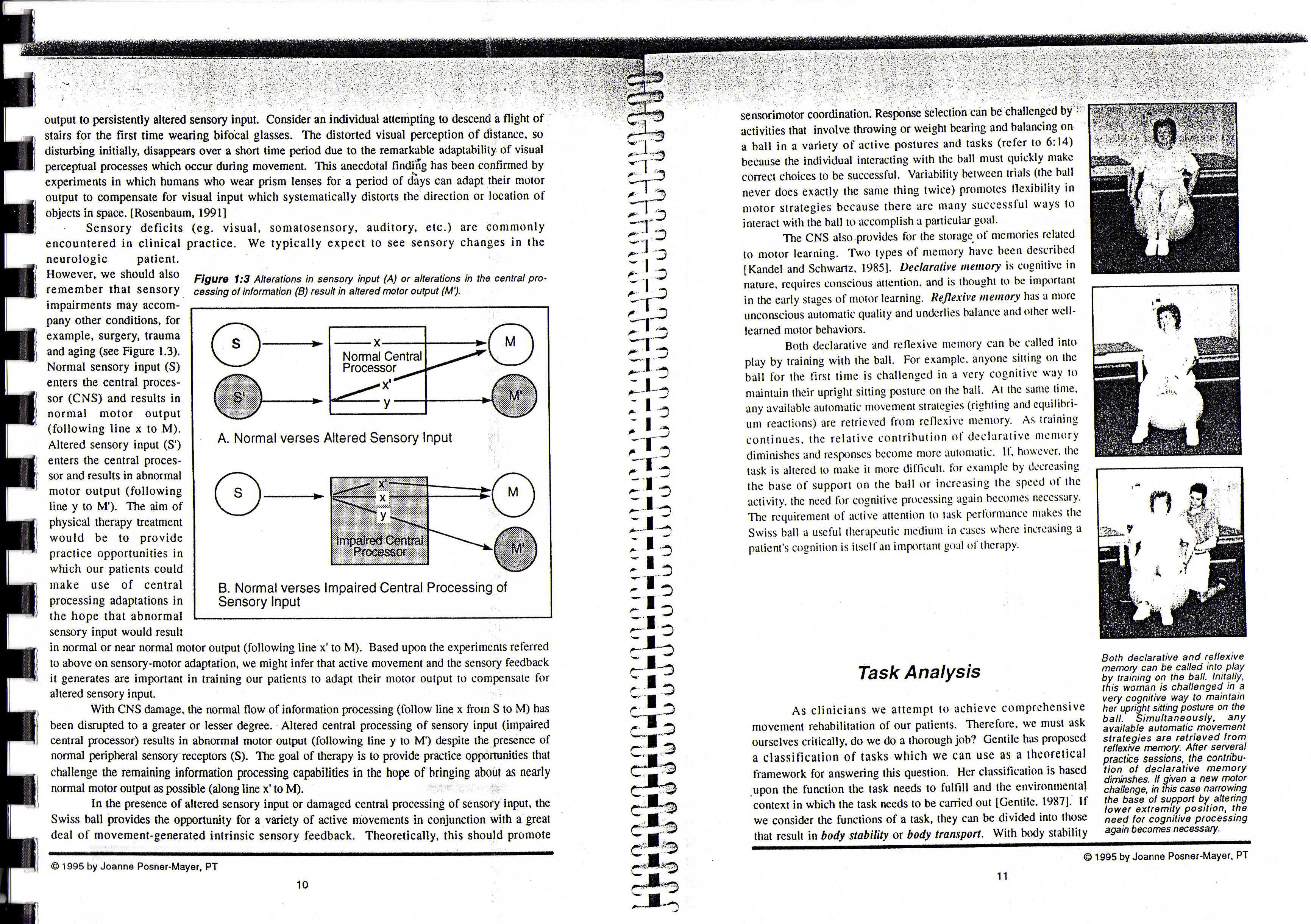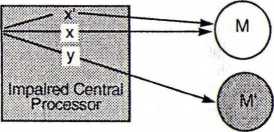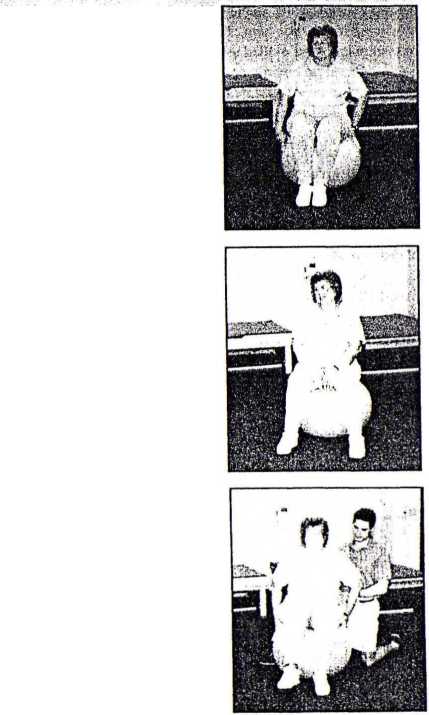73221 img019

output to persistently altered sensory input. Consider an individual attempting to descend a flight of stairs for the ftrst time wearing bifocal glasses. The distorted visual perception of distance, so disturbing initially, disappears over a short time period due to the remarkable adaptability of visual perceptual processes which occur during movement. This anecdotal finding has been confirmed by experiments in which humans who wear prism lenses for a period of days can adapt their motor output to compensate for visual input which systematically distorts the direction or location of objects in space. [Rosenbaum, 1991]
Sensory deficits (eg, visual, somatosensory, auditory, etc.) are commonly encountered in clinical practice. We typically expect to see sensory changes in the neurologie patient.
However, we should also Figurę 1:3 Alteralions in sensory input (A) or alterations in the central pro-remember that sensory cessing of inlormation (B) result in altered motor output (M). impairments may accom-pany other conditions, for example, surgery, trauma and aging (see Figurę 1.3).
Normal sensory input (S) enters the central proces-sor (CNS) and results in normal motor output (following linę x to M).
Altered sensory input (S1) enters the central proces-sor and results in abnormal motor output (following linę y to M'). The aim of physical therapy treatment would be to provide practice opportunities in which our patients could make use of central Processing adaptations in the hope that abnormal sensory input would result in normal or near normal motor output (following linę x' to M). Based upon the experiments referred to above on sensory-motor adaptation, we might infer that active movement and the sensory feedback it generates are important in training our patients to adapt their motor output to compensate for altered sensory input.
With CNS damage, the normal flow of information processing (follow linę x from S to M) has been disrupted to a greater or lesser degree. Altered central processing of sensory input (impaired central processor) results in abnormal motor output (following linę y to M') despite the presence of normal peripheral sensory receptors (S). The goal of therapy is to provide practice opportunities that challenge the remaining information processing capabilities in the hope of bringing about as nearly normal motor output as possible (along linę x' to M).
In the presence of altered sensory input or damaged central processing of sensory input, the Swiss bali provides the opportunity for a variety of active movements in conjunction with a great deal of movement-generated intrinsic sensory feedback. Theoretically, this should promote

|
r( | |
|
Normal Central Processor | |
|
y |

0


© 1995 by Joannę Posner-Mayer, PT
sensorimotor coordination. Response selection can be challenged by “ activities that involve ihrowing or weighl bearing and balancing on a bali in a variety of aclive postures and tasks (rcfer lo 6:14) because the individual intcracling with the bali musi quickly make correct choices to be successful. Variability between trials (the bali never does exactly the same thing twice) promotes llcxibility in motor strategies because there are many successful ways to internet with the bali to accomplish a particular goal.

The CNS also provides for the storage of mcmories relalcd to motor learning. Two types of ntemory have been described [Kandel and Schwartz. 1985]. Declaralive memory is cognitive in naturę, requires conscious attenlion. and is thought to be important in the early stages of motor learning. Keflexive memory has a morę unconscious automatic quality and underlies balance and olher wcll-learned motor behaviors.
Both dedarative and reflexive memory can be called into play by training with the bali. For example. anyone silting on the bali for the first time is challenged in a very cognitive way to maintain their upright sitling posturę on the bali. At the same time, any availablc automatic movement strategies (righting and equilibri-unt reactions) are retrieved front rcflexive memory. As training continues, the relative contribution of dcdaralWc memory dintinishes and responses beconte ntore automatic. if. howecer. the łask is altered to make it ntore dilTtcult. for example by decrcasing the base of support on the bali or inereasing the speed of Ute activity. the need for cognitive processing again becontes necessary. The requirentent of active attenlion to łask performance makes the Swiss bali a useful therapcutic medium in cases where inereasing a patienfs cognition is itself an important goal of therapy.
Both declarative and reflexive memory can be called into play by training on the bali. Initally, this woman is challenged in a very cognitive way to maintain her upright sitting posturę on the bali. Simultaneously, any available automatic movement strategies are retrieved from reflexive memory. After sen/eral practice sessions, the contribution of declarative memory diminshes. If given a new motor challenge, in this case narrowing the base of support by altering lower extremity position, the need for cognitive processing again becomes necessary.
Task Analysis
As clinicians we attempt to aehieve comprehensive movement rehabilitalion of our patients. Therefore. we must ask ourselves critically, do we do a thorough job? Gentile has proposed a classification of tasks which we can use as a theoretical framework for answering this question. Her classification is bascd upon the function the task needs to fulfili and the environmenta| context in which the task needs to be carried out [Gentile, 1987]. If we consider the functions of a task, they can be divided into those that result in body stability or body transport. With body stability
© 1995 by Joannę Posner-Mayer, PT
11
Wyszukiwarka
Podobne podstrony:
FOREWORD This Study Guide has been prepared to aid petroleum professionals studying for the SPE Petr
Logistyka - nauka It is necessary to make a lot of irwestment in the infrastructure in order to adap
uni71 a warm welcome/reception a flight of stairs to seek (sought, sought) to .. rift to h
423 (9) 396ConservationROSĘJOHNSON The conservation brief was: -To advise on suitable storage for th
- 12- Hartmann, Sweden meaningful work and training to otherwise idle youth on a rather Iow level of
DSC04764 to interview 50 people, and for the sake of convenience you decide to interview both the hu
DSC04857 456 Chapter 6: Introduction to (a) Assuming that cr = 30 for the population of older studen
Good Yahoo example of writing for the web Maynooth ubrary project to create 150 building jobs 24 min
Student access codęMyEnglishLab USE THIS CARO TO ACCESS YOUR DIGITAL PRODUCTMyEnglishLab FOR THE&nbs
img019 (16) They walk to her fire, and stand on the feet. And still she sits, and still she sews, an
21vel02 Figurę 21.2. /Visual Basic I applications j /- The Windows Print Manager■> Output to
creating a context2 FlowcharM ■1 Start (MCU) i Read: xajnputo <= 25 ? Set Outpu
więcej podobnych podstron